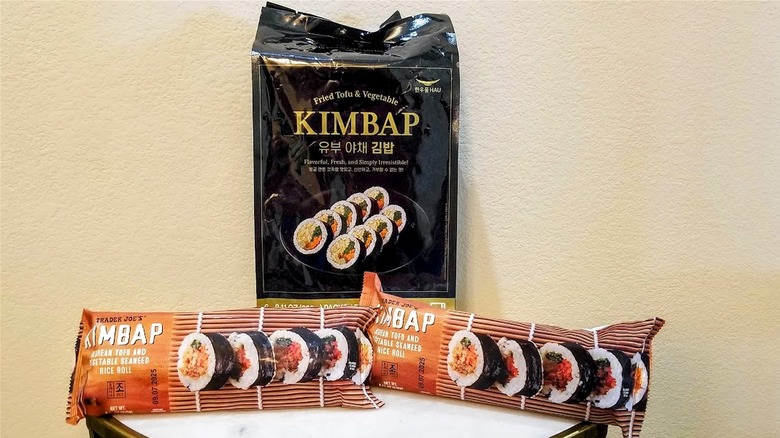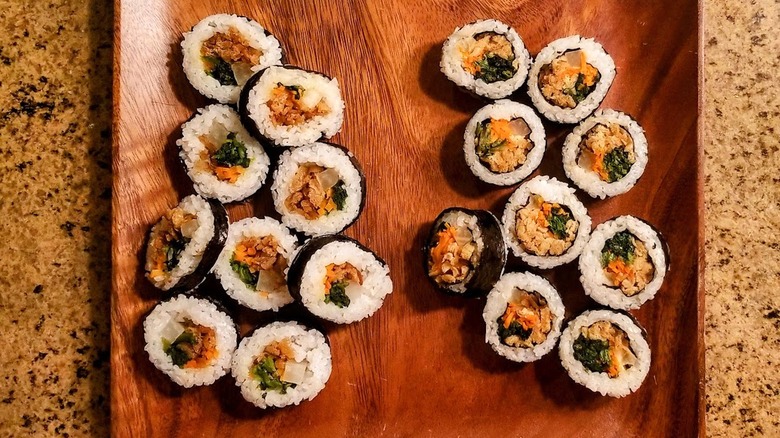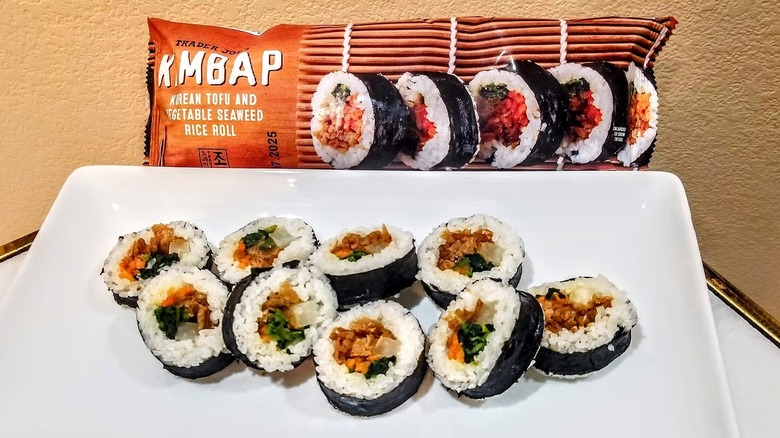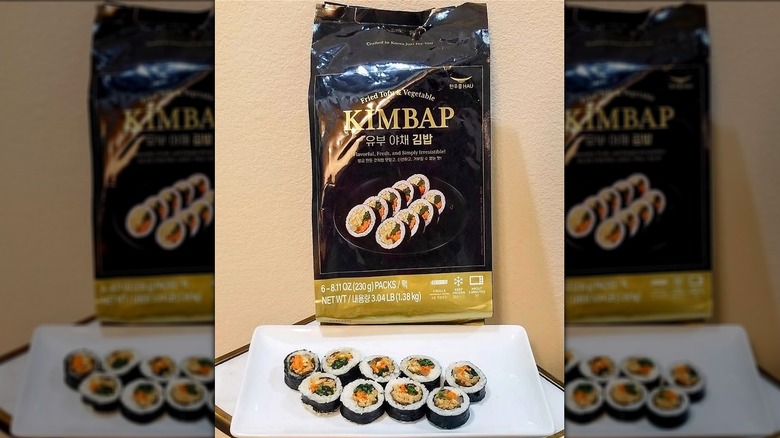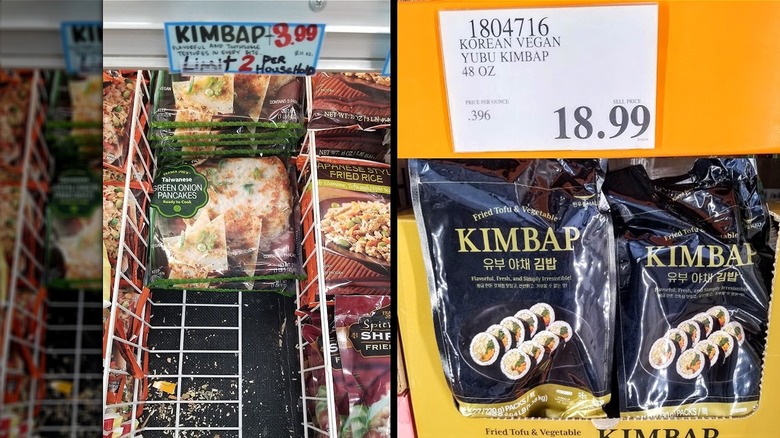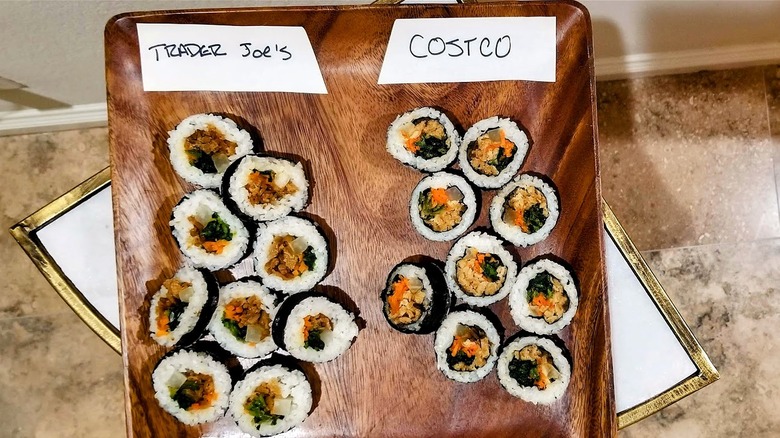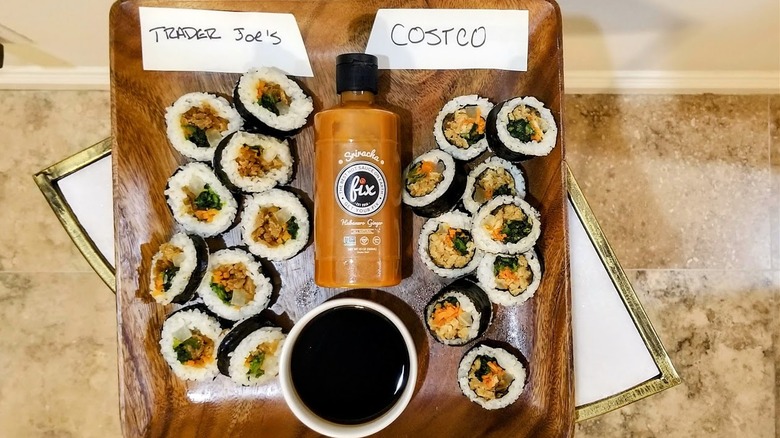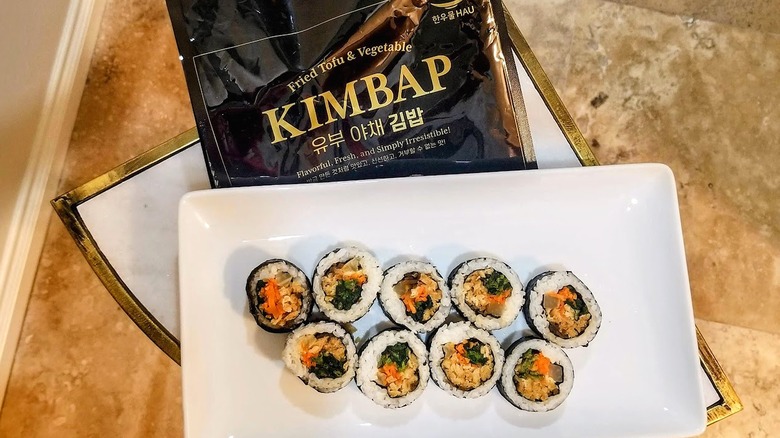Costco Vs Trader Joe's: Who Has The Better Frozen Kimbap?
Kimbap is one of Korea's favorite street foods. It includes an array of ingredients with rice rolled inside a dried seaweed wrapper. Kimbap has been a staple of the country's cuisine since the 1930s, as it is easy to transport, can be eaten with your hands, is nourishing, and may include any combination of cooked meat and vegetables you have readily available. While the finished products are a convenient lunch or snack-time favorite, making the rolls at home takes time. You must prepare the rice, marinate and cook the meat, and prep the vegetables.
In the summer of 2023, Trader Joe's made kimbap a little more accessible to kimbap lovers in America by introducing a vegetarian version of the rolls to its customers, setting off a kimbap craze, with the product selling out at stores nationwide. Even today, the product is still in high demand, with customers being allowed to purchase only two products per household daily.
In April 2024, social media began buzzing that Costco was introducing its veggie-style version made in South Korea in select locations across the U.S., which had me wondering which kimbap is better. To decide, I picked up each product and put them through a rigorous taste test to find out who makes the better rice roll.
All prices are as of the date of publication and may vary based on region.
What is kimbap?
Koreans have been wrapping rice around dried seaweed sheets (or laver) since the late 14th century. However, kimbap did not become a fixture in modern Korean cuisine until the first half of the 1900s, as previously mentioned. The name's translation means "seaweed" (kim or gim) and "rice" (bap).
The dish is similar to a sushi maki roll. However, unlike traditional sushi, there is no raw fish inside. Instead, the typical ingredients are cooked and pickled, including meat, vegetables, egg, fish cake, and white rice wrapped in dried laver sheets. Another key difference is the flavoring of the rice. In sushi, the rice is seasoned with sugar, salt, and vinegar; whereas in a kimbap, sesame oil and salt are used to dress the rice, giving it an earthy, nutty taste and enhancing the flavor of the other ingredients.
The popularity of Korean rice rolls is undeniable within its home country. But that is not the only place. From coast to coast, kimbap is well-loved throughout America. Diners flock to the best restaurants to get kimbap in Los Angeles to the top spots for kimbap in New York City, with some featuring Michelin-starred chefs. These chefs create unique kimbap combos like a tuna salad with avocado kimbap or pork belly and homemade kimchi. Having a kimbap on hand anytime in your freezer only increases our options to enjoy it, which is why I'm excited that these Trader Joe's and Costco options are available.
Trader Joe's kimbap
Trader Joe's loves to make life a little easier, more flavorful, and always more fun, which is why the release of its kimbap has been so successful. Of course, you can make homemade kimbap at home; however, it is time-consuming, especially when TJ's veggie kimbap Korean rice rolls can be ready on the table in minutes.
The grocery store's website notes that its version of a kimbap, directly from the Republic of Korea, is a vegetarian option loaded with root vegetables, greens, pickles, and supposedly braised tofu. However, in the ingredient list, the tofu is stated as fried (just like Costco's version). The burdock root, however, is braised and combined with stir-fried carrots, seasoned spinach, and sweet and savory pickled radishes. TJ's wraps the various prepared vegetables in a considerable amount of sesame-seasoned white rice, all tucked inside a sheet of dried seaweed.
Preparing Trader Joe's kimbap at home or in the office is a breeze, as the rice roll goes from the freezer to the microwave to the table in around three minutes, making it a great option for on-the-go lunches or dinners. TJ's suggests the texture will improve if you pan-fry the nine pre-cut slices in oil for a few minutes, helping to crisp the rice. However, frying TJ's kimbap will increase the fat and calories in the rice roll.
Costco's kimbap rolls
As expected from the big box store, Costco aims to ensure you get the best bang for your buck, delivering a giant 3-pound bag of fried tofu and vegetable kimbap rolls for a great price. The vegetarian rolls come straight from South Korea via the Hanwoomul Company, a producer of a variety of Korean staples. This kimbap option includes a mix of the same ingredients as in TJ's roll, along with garlic, onion, shitake mushroom concentrate, kelp extract, various vinegars, sugars, and more — making the wholesaler's version a complex, hearty, vegetable-forward rice roll with a rich flavor profile.
However, the product includes the Proposition 65 warning on its packaging, noting that this kimbap may contain lead. I found this unfortunate, as the mineral can lead to congenital disabilities and cancer, which you should take into consideration when purchasing the product. Aside from that, Costco's kimbap — cut into nine pre-portioned slices — shows a high level of authenticity with a satisfying, appealing, and natural vegetable flavor. It, too, goes from the freezer to the table in three minutes after microwaving.
Is Trader Joe's or Costco's kimbap more affordable?
Trader Joe's is known for introducing unique flavors and international finds to its customers, often at more affordable prices than elsewhere. It is one of the essential facts about TJ's any savvy shopper should know. Costco is also a known leader when it comes to affordability. However, you'll end up buying an item in bulk versus as a single unit, like 24 rolls of paper towels or toilet paper instead of a more manageable four-pack.
Comparing the prices of the two kimbaps, it is no surprise that Costco's cost per roll is better, as my six-pack of rolls came to $18.99 (or, $3.17 per roll). Trader Joe's offering is $3.99 per roll, which — though more expensive than Costco's option — is still a reasonable price for a filling lunch or mid-day snack. And as Trader Joe's limits customers to two rolls per household, its kimbap will take up less valuable space in your freezer.
I suggest going to your TJ's store early if you choose to buy its kimbap. After calling ahead to confirm availability, it took me three trips to the store to finally find it in stock to purchase, as the grocer won't hold the product aside.
Which kimbap is healthier?
Trader Joe's and Costco deliver the same size rice roll, each weighing 230 grams or 8.11 ounces. Though TJ's breaks the roll into three servings per container, there is a high likelihood you'll enjoy the entire kimbap. As such, Costco notes its nutritional information with the serving size of the whole roll. We'll compare the two products side-by-side, whole roll to roll.
Costco's option includes a dizzying array of ingredients, including various sugars, creating a roll with 9 grams of added sugars compared to about 6 in Trader Joe's. However, the wholesaler's option has fewer calories and less fat: Costco's kimbap has 370 calories and 8 grams of fat compared to TJ's 420 calories and 12 grams of fat. This could be due to the first couple of ingredients in Trader Joe's kimbap's list: rice seasoned with sesame and soybean oil, and fried tofu. Costco's also leads with rice, followed by pickled radish and stir-fried carrots, with its blend of seasoning oils sitting low on the ingredient list, indicating not as much is used. Both options are high in sodium, with over 40% of your daily allotment in one roll, which may affect heart health.
Costco's kimbap has slightly more vitamins and minerals, with 10% of your daily iron and calcium and 8% potassium. TJ's offers 6% of your daily potassium, 6% iron, and 12% calcium. The remaining nutritional elements are relatively similar, each offering around 11 grams of protein and 4 grams of fiber.
Taste Test
When I observed the two rolls side by side, the Trader Joe's option appeared larger. Even though the two products weighed the same amount, the kimbap from TJ's had more rice and was noticeably lighter and fluffier than the kimbap from Costco. While this may be preferable to some, it also meant the roll wasn't as compact as Costco's kimbap. Consequently, the ingredients kept falling out of the roll from TJ's when I removed it from the microwavable tray.
Though weighing the same, the kimbap from Costco was more dense than Trader Joe's. Hanwoomul portioned the roll generously with a considerable amount of vegetables and less rice, which I loved, and it had a richer depth of flavor than the kimbap from TJ's. The texture of both rolls was oily — likely due to the inclusion of various oils used when cooking the rice and vegetables — and the fat gave both kimbap versions a greasier texture than you'll find in a classic norimaki sushi roll.
Additionally, neither store's kimbap included a sauce like soy, sriracha, or gochujang (with its long history in Korea). However, I found both rolls benefited when one of those sauces was incorporated. Both kimbap rolls became somewhat chewy shortly after cooking, so keep this in mind if you pre-cook the kimbap to take on a picnic or a hike.
The Verdict: Costco edges out Trader Joe's in frozen kimbap
After comparing frozen kimbap rolls sold by Trader Joe's and Costco, and weighing all options, there was no question regarding the winner: Costco's product far outweighed the competition. For starters, the robust vegetable flavor was more dominant in the big box store's Korean rice roll, and the loaded roll was well-packed with a mix of highly seasoned, nicely cooked ingredients. Costco's kimbap contained just the right amount of savoriness from the sesame, earthiness from the tofu, burdock, and carrots, and a touch of tang from the pickled radish — all with less fat and calories than the kimbap from Trader Joe's.
While the texture of Costco's kimbap was denser than Trader Joe's, I liked that it didn't feel or taste starch-heavy thanks to the inclusion of more veggies than rice. In that sense, some may enjoy the kimbap from TJ's more if they aren't a fan of veggie-heavy dishes. However, I felt Costco's veggie stuffed rice roll had a richer, more authentic taste that overtook the less compact option. Since I also found Costco's kimbap to be a bit less greasy than the product from TJ's, Costco's kimbap was the superior choice.
